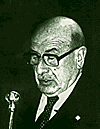| The sixties | ||
After 1960, a number of changes in economic and social matters brought with them a slight relaxation of censorship. Examples of this were the renewed publication of journals which had previously been prohibited such as Grial, the first celebration of the "Día das Letras Galegas" by the "Real Academia Galega", new publishing houses such as Ediciós do Castro, and the birth of new cultural associations in defence of Galician: O Facho, O Galo, a Asociación Cultural de Vigo... The Galician University also became involved in this movement and took an active part with the creation in 1965 of the Department for Galician Language and Literature with Ricardo Carballo Calero holding the Chair. Six years later the "Instituto da Lingua Galega" was created and has not ceased its research work since. In the fifties, literary works of a more solid nature were again being published in Spain. Lyric poetry once again was the first manifestation of the literary rebirth. Longa noite de pedra by Celso Emilio Ferreiro in 1962 represented the social and civic themes which characterised poetry in the sixties. Lueiro Rey, Bernardiño Graña, Manuel María are some of the authors of this poetry which attempted to combine political and literary thought. Narrative writing suffered a long period of drought from 1936 to 1951, when Carballo Calero published his first novel A Xente da Barreira. Between the fifties and sixties three important writers, Alvaro Cunquieiro, Blanco Amor and Anxel Fole, each with their individual styles, created works of universal quality. In the sixties, Gonzalo Mourullo, Méndez Ferrín and Carlos Casares, amongst others, echoed the innovations appearing in European writing by creating what was called "Nova narrativa", a renovative and revitalising movement in Galician prose-writing. |
 Carballo Calero.  Blanco Amor. | |
Back | ||